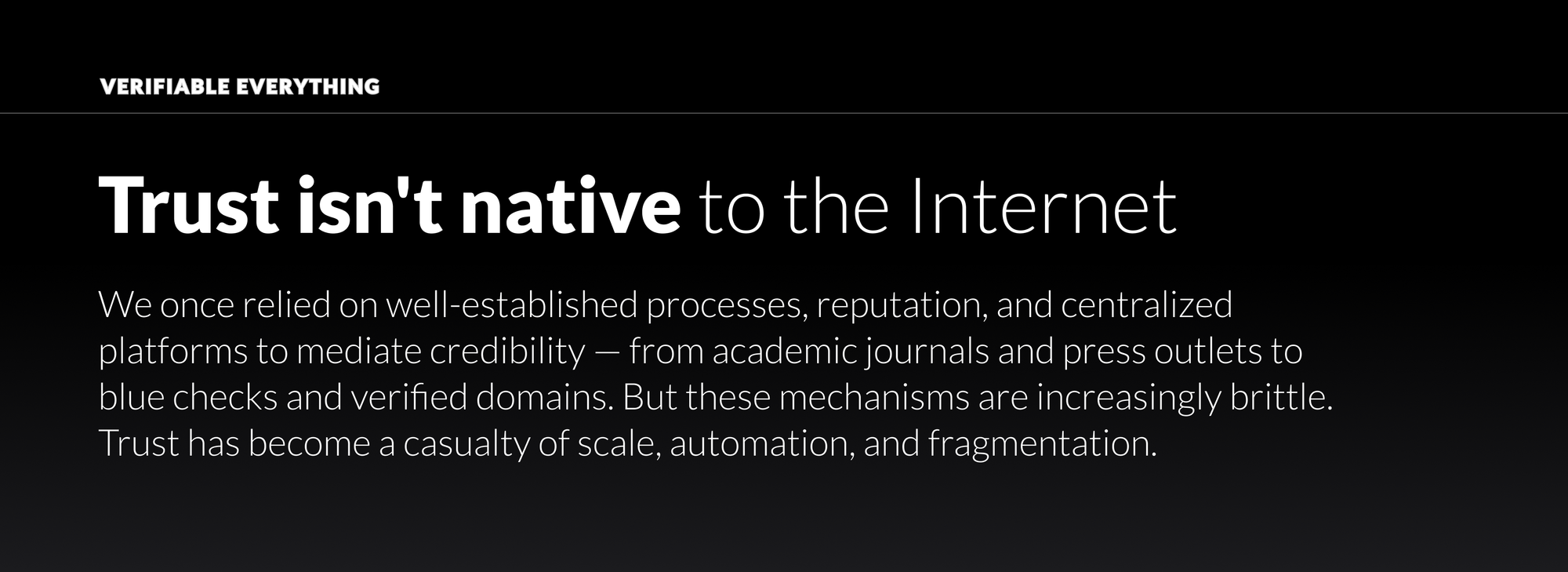2025 Nexus Wrapped
2025 was a year of scale. From a record-breaking testnet to a quadrillion FLOPS of verifiable compute, you helped turn

We are living through a crisis of clarity. In just a few years, the Internet has transformed from a place where truth could be approximated through reputation, authority, or context — to one where appearances deceive, and signals of trust collapse under their own weight.
Generative AI can now produce text, images, video, and voice indistinguishable from those created by humans. That combined with the fact that data moves faster than ever creates conditions where misinformation, deepfakes, and bots are becoming harder (if not impossible) to detect. Even legitimate content is getting difficult to manage: It’s unclear who wrote what, what is real, or whether we can take any of the information at face value.
Put another way: Trust isn’t native to the Internet. We once relied on well-established processes, reputation, and centralized platforms to mediate credibility — from academic journals and press outlets to blue checks and verified domains. But these mechanisms are increasingly brittle. Trust has become a casualty of scale, automation, and fragmentation.

Amid this blur, a new paradigm is emerging — one that doesn’t ask us to believe, but to verify.
We call this shift verifiability: the ability to transparently prove the truth of a claim, the origin of content, the performance of a model, or the legitimacy of a user — without appealing to a central authority. This vision of verifiability relies on cryptographic proofs rather than policies, secure hardware rather than bureaucracies, transparent audit trails rather than paper trails, and content provenance rather than mastheads. It’s less about who said something, and more about how it can be independently confirmed.
The old web was built on mechanisms of trust — a web of implicit assumptions and informal signals. The new web will be built on verification — a web of explicit, provable guarantees.
This change mirrors the foundational evolution of the Internet itself. Where the early web depended on centralized trust (passwords, platforms, policies), the next layer depends on decentralization and cryptography.
The ability to independently verify the legitimacy of data isn’t just utopian fantasy — it’s a practical shift made possible by new infrastructure.
In recent years, several technological advances (like the Nexus zkVM) have made large-scale verifiability possible for the first time. Cryptographic primitives like zero-knowledge proofs (ZKPs) allow facts to be proven without revealing sensitive details. Secure execution environments (like the Nexus Layer 1) enable tamper-proof computing. Distributed compute networks (like the Nexus Network) parallelize trust across nodes rather than concentrating it in intermediaries.
In addition to what we are building at Nexus, there are other efforts underway aimed at making verifiability an Internet standard. Content authenticity protocols such as the Coalition for Content Provenance and Authenticity, or C2PA, add digital signatures and provenance data directly to media assets. And attestation frameworks allow machines, models, and identities to prove what they are — and that they haven’t been tampered with.
Together, these new kinds of tools form the scaffolding for a Verifiable Internet: one where data can be traced, software can prove its behavior, and AI can be held accountable for its outputs.

Why does this matter? Because without verifiability, trust becomes more complicated — and without trust, critical systems break down.
A few high level examples: The political process becomes unsustainable when disinformation and synthetic media undermine the legitimacy of government. In modern healthcare, not knowing specifics about AI models make it impossible to audit results or double-check decision-making. In media and communication, the inability to verify content origin can create conditions for manipulation. In the realm of digital identity, the stakes range from fraud to complex crimes.
In the context of the digital world, verifiability isn’t a luxury. It’s a foundational requirement for the next era of the internet — one where people, applications, and systems can rely on a chain of proof-carrying data, not just outward appearances.
Big picture: We have a lot of work to do. But with regard to this post, this is the first in a series exploring the verifiable world – and how it’s being built. In the coming weeks, we’ll go deeper into key domains of verifiability, including:
Each post will examine the problems at hand, the enabling technologies, and the design trade-offs ahead. But more importantly, they’ll frame verifiability as a societal shift — not just a technical upgrade. This isn’t just about protecting data or proving facts. It’s about rebuilding every layer of the Internet stack.